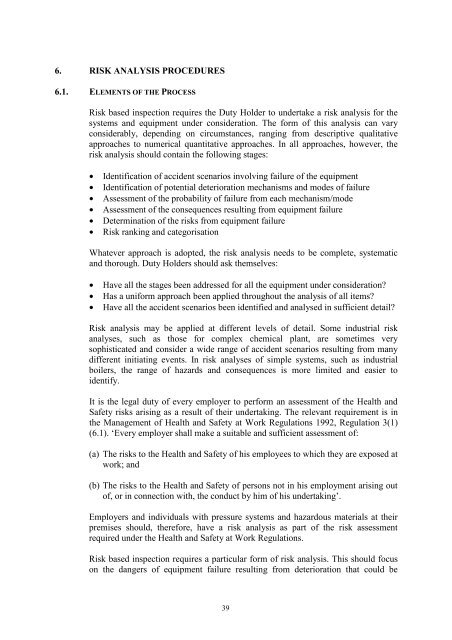Best Practice for Risk Based Inspection
risk based inspection
risk based inspection
You also want an ePaper? Increase the reach of your titles
YUMPU automatically turns print PDFs into web optimized ePapers that Google loves.
6. RISK ANALYSIS PROCEDURES<br />
6.1. ELEMENTS OF THE PROCESS<br />
<strong>Risk</strong> based inspection requires the Duty Holder to undertake a risk analysis <strong>for</strong> the<br />
systems and equipment under consideration. The <strong>for</strong>m of this analysis can vary<br />
considerably, depending on circumstances, ranging from descriptive qualitative<br />
approaches to numerical quantitative approaches. In all approaches, however, the<br />
risk analysis should contain the following stages:<br />
• Identification of accident scenarios involving failure of the equipment<br />
• Identification of potential deterioration mechanisms and modes of failure<br />
• Assessment of the probability of failure from each mechanism/mode<br />
• Assessment of the consequences resulting from equipment failure<br />
• Determination of the risks from equipment failure<br />
• <strong>Risk</strong> ranking and categorisation<br />
Whatever approach is adopted, the risk analysis needs to be complete, systematic<br />
and thorough. Duty Holders should ask themselves:<br />
• Have all the stages been addressed <strong>for</strong> all the equipment under consideration?<br />
• Has a uni<strong>for</strong>m approach been applied throughout the analysis of all items?<br />
• Have all the accident scenarios been identified and analysed in sufficient detail?<br />
<strong>Risk</strong> analysis may be applied at different levels of detail. Some industrial risk<br />
analyses, such as those <strong>for</strong> complex chemical plant, are sometimes very<br />
sophisticated and consider a wide range of accident scenarios resulting from many<br />
different initiating events. In risk analyses of simple systems, such as industrial<br />
boilers, the range of hazards and consequences is more limited and easier to<br />
identify.<br />
It is the legal duty of every employer to per<strong>for</strong>m an assessment of the Health and<br />
Safety risks arising as a result of their undertaking. The relevant requirement is in<br />
the Management of Health and Safety at Work Regulations 1992, Regulation 3(1)<br />
(6.1). ‘Every employer shall make a suitable and sufficient assessment of:<br />
(a) The risks to the Health and Safety of his employees to which they are exposed at<br />
work; and<br />
(b) The risks to the Health and Safety of persons not in his employment arising out<br />
of, or in connection with, the conduct by him of his undertaking’.<br />
Employers and individuals with pressure systems and hazardous materials at their<br />
premises should, there<strong>for</strong>e, have a risk analysis as part of the risk assessment<br />
required under the Health and Safety at Work Regulations.<br />
<strong>Risk</strong> based inspection requires a particular <strong>for</strong>m of risk analysis. This should focus<br />
on the dangers of equipment failure resulting from deterioration that could be<br />
39



